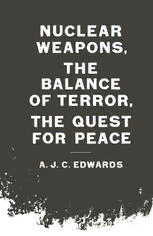
Nuclear Weapons, the Balance of Terror, the Quest for Peace PDF
Preview Nuclear Weapons, the Balance of Terror, the Quest for Peace
NUCLEAR WEAPONS, THE BALANCE OF TERROR, THE QUEST FOR PEACE NUCLEAR WEAPONS, THE BALANCE OF TERROR, THE QUEST FOR PEACE A.J.C. Edwards © A.J.C. Edwards 1986 Softcover reprint of the hardcover 1st edition 1986 978-0-333-39564-6 All rights reserved. No reproduction, copy or transmission of this publication may be made without written permission. No paragraph of this publication may be reproduced, copied or transmitted save with written permission or in accordance with the provisions of the Copyright, Designs and Patents Act 1988, or under the terms of any licence permitting limited copying issued by the Copyright Licensing Agency, 90 Totten ham Court Road, London W1P OLP. Any person who does any unauthorised act in relation to this publication may be liable to criminal prosecution and civil claims for damages. First published by MACMILLAN PRESS LTD Houndmills, Basingstoke, Hampshire RG21 6XS and London Companies and representatives throughout the world ISBN 978-1-349-08133-2 ISBN 978-1-349-08131-8 (eBook) DOI 10.1007/978-1-349-08131-8 A catalogue record for this book is available from the British Library. This book is printed on paper suitable for recycling and made from fully managed and sustained forest sources. Transferred to digital printing 1999 Contents List of Tables, Figures, and Appendix Figures xi List of Abbreviations xii Preface XV THE BALANCE OF TERROR 2 BASIC THEORY AND THE E\{OLUTION OF STRATEGIC POSTURES 3 Introduction 3 Basic Theory 3 Comparison with Earlier Balances of Power 4 Unilateral Terror 4 The Balance of Terror 6 Mutual Assured Destruction 7 Flexible Response 9 Subsequent Developments 11 Soviet Postures 13 3 HOW IT CAME TO BE 14 Introduction 14 Birth of Nuclear Age 14 Political Tensions 17 The Balance of Terror 22 Conclusion 27 4 IS IT NECESSARY? 28 Introduction 29 Western Perceptions of the Soviet Threat 29 v vi Contents Words 30 Deeds 32 Soviet Perceptions of the Western Threat 34 Conclusion 37 5 NUCLEAR WEAPONS AND WORLD POLITICS 38 Introduction 38 Military Strength and Political Power 38 Limitations on Political Power of Strong Countries 40 Will-power of Weaker Countries 41 Will-power of Strong Countries 42 Perceptions and Signals 42 Conventional Capabilities World-wide 43 Other Nuclear Countries 44 Relative Military Strengths 47 Attitudes to Use of Military Force 47 Taunting Goliath 48 Global Political Effects 48 Bipolarity 49 The Status Quo and Spheres of Influence 49 Conventions of International Behaviour 50 The Incentive to Bargain and Detente 51 Conclusion 52 6 INTRINSIC STABILITY 54 Intrinsic and Dynamic Stability 54 Preliminary Exposition 55 Risk-aversion and Unacceptable Damage 57 Perceived Will to Retaliate 58 Intelligence 60 Communications 61 7 MILITARY CAPABILITIES 62 First and Second Strikes, Counter-force and Counter-city 62 Second-strike Capability to Inflict Unacceptable Damage 63 Alternative Formulations 66 First-striker's Advantage and the Incentive to Strike First 67 Contents vii Counter-force Exchange Rates 70 The Development of Counter-force Capabilities 71 Ways of Reducing First-striker's Advantage 75 Launch on Assessment 80 Counter-city Second-strike Capabilities and the 'Strike and Bargain' Scenario 81 First-striker's Advantage and Deterrence against Conventional Attack 84 Vulnerability of Cities 85 Conclusions 88 8 WAR-FIGHTING AND MINIMUM DETERRENCE 90 Deterrence and War-fighting Capability 90 Other Needs for a War-fighting Capability 93 Some Elements in a War-fighting Capability 95 Civil Defence and War-fighting Capability 96 Minimum Deterrence and 'Sufficiency' 99 9 ARMS CONTROL 102 Shared Interests 102 Agreements 103 Objectives 105 Problems 108 SALT and MBFR 111 START, INF and the Geneva Negotiations 114 Mutual and Stable Minimum Deterrence (MSMD) 116 10 DYNAMIC STABILITY 117 Introduction 117 Full-scale Attack Scenario 117 Tension and Provocation Scenarios 118 Proliferation, Accident and Madness Scenarios 122 Misunderstanding 122 Escalation and the Boundaries of Crisis 123 Factors Affecting Escalation 124 Crisis Management 126 viii Contents 11 EXTENDED DETERRENCE AND FIRST NUCLEAR USE 129 Introduction 129 Extended Deterrence 129 First Nuclear Use 130 Credibility 131 Role of Theatre Nuclear Weapons 134 Theatre Nuclear Weapons and Deterrence against Conventional Attack 135 Theatre Nuclear Weapons and Deterrence against Theatre Nuclear Attack 137 Stopping a War Once Begun 138 Fighting the War and Keeping it Limited 139 Flexibility 139 Circumstances of First Nuclear Use 141 Intermediate-range Theatre Nuclear Forces 144 Objections to Intermediate-range Nuclear Forces Modernisation 148 The 'Zero Option' 150 United States or NATO Deployments 151 12 LIMITING NUCLEAR WAR 154 Could Nuclear Conflict be Limited? 154 Firebreak Visibility 157 Firebreaks by Announcement 159 Firebreaks and Flexibility of Weapon Systems 161 Firebreaks and Political Will 161 General Conclusions 162 Implications for NATO Strategy 163 13 POLICIES TOWARDS THE BALANCE OF TERROR: ( 1) REJECTION AND ABDICATION 165 Introduction 165 Need for a Balance of Terror 165 Advantages of a Balance of Terror 166 Disadvantages of a Balance of Terror 167 Alternative Policies 170 General and Complete Disarmament by Agreement 171 Unilateral Complete Disarmament 174 Contents ix Nuclear Disarmament by Agreement 174 Unilateral Nuclear Disarmament 178 The Moral Dimension 179 Forswearing Aggression in Any Form 180 Forswearing First Nuclear Use 181 European Options 182 A European Nuclear-free Zone 184 Unilateral Withdrawal of Nuclear Forces from West European Soil 186 Independent Nuclear Deterrents 189 Conclusion 195 14 POLICIES TOWARDS THE BALANCE OF TERROR: (2) ACCEPTANCE AND IMPROVEMENT 197 Introduction 197 Reasons for Guarded Optimism 197 Main Threats to Stability 198 Hardening of Soviet Policies 199 Political Problems in the West 200 Political Turbulence World-wide 203 First-striker's Advantage 203 Hazards of Crisis 205 Combinations of Unstable Factors 207 Postscript on Nuclear Proliferation 207 Postscript on Defences against Nuclear Weapons 209 Some Policy Implications 210 Strategic Postures 210 Political Signals and Detente 211 Military Capabilities 214 Adequacy of Existing Capabilities 218 APPENDIX: THE ALGEBRA OF MUTUAL DETERRENCE AND STABILITY 222 A Simple Model 222 Functional Forms 227 Risk-aversion and the Will to Retaliate 228 Ability to Inflict Unacceptable Damage 229 War-fighting Capability 231 X Contents First-Striker's Advantage 232 Balance of Risk between Striking and Not Striking 235 Deterrence against Conventional Attack 236 Notes and References 238 Index 259
